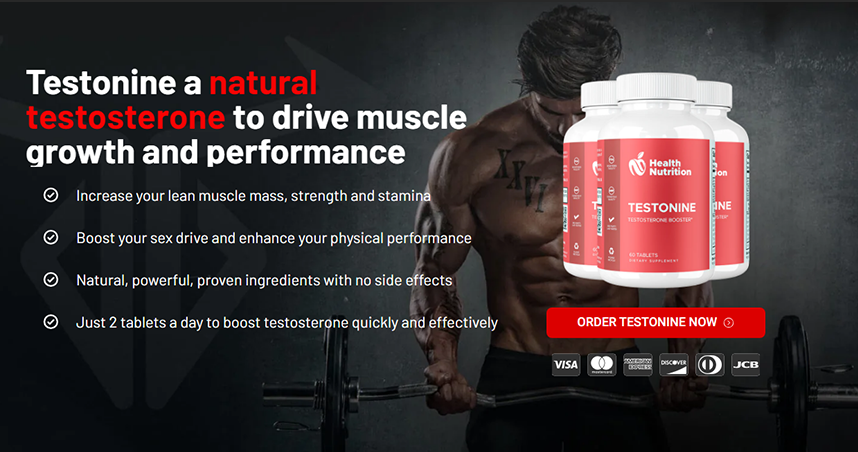
Muscle recovery is where the magic happens—it’s when your muscles repair, grow, and adapt to become stronger. But if you’re consistently sore, fatigued, or unable to recover efficiently, you might be missing a critical piece of the puzzle: testosterone. Testosterone, often hailed as the king of anabolic hormones, plays a vital role in muscle repair and recovery.
Contents
- What is Testosterone’s Role in Muscle Recovery?
- How Testosterone Levels Affect Recovery Times
- Natural Testosterone Boosters for Muscle Recovery
- Dietary Strategies to Boost Testosterone and Recovery
- Exercise Strategies to Support Testosterone and Recovery
- Supplements That Enhance Testosterone and Recovery
- Tracking Progress and Staying Consistent
What is Testosterone’s Role in Muscle Recovery?
Testosterone does more than just build muscle; it’s the conductor of your body’s recovery orchestra. After a workout, your muscles experience microscopic damage that triggers the repair process. Testosterone steps in to lead this process, ensuring your muscles repair and grow stronger.
Protein Synthesis and Muscle Repair
Protein synthesis is the process your body uses to rebuild damaged muscle fibers. Testosterone amplifies this process, ensuring that muscle recovery is efficient and effective. Higher testosterone levels mean your body is better equipped to repair and grow muscle tissue.
Reducing Inflammation
Intense workouts cause inflammation, which contributes to soreness. Testosterone helps regulate this inflammation, reducing pain and speeding up the healing process.
Increasing Cellular Energy
Testosterone enhances mitochondrial function, improving your cells’ ability to produce energy. This translates to quicker recovery and more stamina for subsequent workouts.
Example
After noticing prolonged soreness after workouts, Jake, a 35-year-old runner, focused on boosting his testosterone levels through diet and supplements. Within weeks, he experienced faster recovery and could train more consistently.
How Testosterone Levels Affect Recovery Times
Your testosterone levels determine how efficiently your body can repair itself. Low levels often lead to slower recovery, increased fatigue, and prolonged soreness.
Low Testosterone and Recovery Challenges
When testosterone levels drop, your body’s ability to synthesize protein and repair muscle tissue diminishes. This results in longer recovery times and a greater risk of injury.
Optimal Testosterone Levels for Recovery
Maintaining healthy testosterone levels ensures that your body has the resources it needs to repair muscle fibers quickly. This is particularly important for athletes and fitness enthusiasts who push their bodies regularly.
Example
Susan, a 40-year-old weightlifter, struggled with frequent injuries and prolonged soreness. After optimizing her testosterone through natural boosters, her recovery times improved, and she could lift heavier weights consistently.
Natural Testosterone Boosters for Muscle Recovery
While synthetic options exist, natural testosterone boosters provide a safer, more sustainable approach to enhancing recovery. Here are some effective options:
Tongkat Ali
This Southeast Asian herb reduces cortisol, a stress hormone that suppresses testosterone. By balancing cortisol levels, Tongkat Ali promotes faster muscle recovery.
Ashwagandha
Ashwagandha is a powerful adaptogen that reduces inflammation and improves testosterone levels, supporting both recovery and performance.
Vitamin D
Known as the sunshine vitamin, Vitamin D plays a critical role in testosterone production. Adequate levels support faster muscle repair and stronger bones.
Magnesium
Magnesium enhances free testosterone levels and helps relax muscles, reducing soreness and improving recovery times.
Example
Tom, a 30-year-old CrossFit athlete, incorporated magnesium and Vitamin D into his routine and noticed significantly less post-workout soreness.
Dietary Strategies to Boost Testosterone and Recovery
Your diet is a cornerstone of muscle recovery and testosterone optimization. What you eat directly impacts your body’s ability to repair and grow.
Foods to Include
- Healthy Fats: Avocados, nuts, and olive oil provide the cholesterol needed for testosterone production.
- Protein Sources: Eggs, chicken, and fish fuel muscle repair.
- Zinc-Rich Foods: Oysters and pumpkin seeds support hormonal balance.
- Leafy Greens: Spinach and kale improve energy metabolism and recovery.
Foods to Avoid
- Processed foods
- Excess sugar
- Soy products (may interfere with testosterone production)
Example
Steve, a busy professional, revamped his diet to include more testosterone-friendly foods like salmon and spinach. He noticed quicker recovery times and improved gym performance.
Exercise Strategies to Support Testosterone and Recovery
Not all exercises are created equal when it comes to boosting testosterone and aiding recovery. Incorporating smart training techniques can make a big difference.
Strength Training
Compound movements like squats, deadlifts, and bench presses stimulate testosterone production and improve overall muscle recovery.
High-Intensity Interval Training (HIIT)
HIIT combines bursts of intense effort with recovery periods, boosting testosterone levels while improving endurance and recovery.
Avoid Overtraining
Overtraining increases cortisol and suppresses testosterone. Incorporate rest days to give your body time to repair and grow.
Example
Lisa, a 29-year-old personal trainer, added more compound lifts to her routine and reduced her training volume. Her recovery improved, and she started hitting new personal bests.
Supplements That Enhance Testosterone and Recovery
While natural foods and exercise form the foundation, supplements can provide an additional boost for recovery and testosterone optimization.
Top Supplements
- Zinc: Supports testosterone production and muscle repair.
- Creatine: Improves strength and recovery.
- Omega-3 Fatty Acids: Reduces inflammation and enhances recovery.
- Ashwagandha: Balances cortisol and boosts testosterone.
Example
David, a 45-year-old cyclist, added creatine and omega-3 supplements to his regimen and experienced faster recovery and less soreness after long rides.
Tracking Progress and Staying Consistent
Improving testosterone and recovery takes time and consistency. Tracking your progress ensures you stay on the right path.
Monitor Recovery Times
Track how long it takes for soreness to subside after workouts. Improvements often signal better testosterone levels.
Adapt Your Routine
If something isn’t working, adjust your diet, supplements, or training program to find what works best for you.
Celebrate Wins
Whether it’s completing a workout without soreness or lifting heavier weights, acknowledge your progress and stay motivated.

